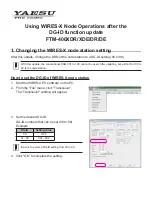
60
SD Series Technical Manual
MDS 05-4846A01, Rev. H
•
Destination IP Address
—Specifies the IP address associated with the
device connected through the RJ-45 modular connector on the
radio’s front panel (typically a PC). Any valid IP address may be
entered.
•
Destination IP Port
—Used to specify a port number for the RJ-45
modular connector on the connected device (typically a PC). Port
numbers below 2000 should be avoided, as some are reserved for
special applications in data networks.
•
TCP Server IP Address
—IP address of the TCP server being used.
•
TCP Server IP Port
—Port number of the TCP server being used.
•
Connection Timeout
—Used to specify a time in seconds, after which
the connection will be dropped following a period of inactivity.
•
Persistent Connection
—When set to
Yes
, the connection to the server
is maintained continuously, even during periods of inactivity.
•
Committing Configuration
—Once you are satisfied with all of the set-
tings on the screen, you make them active by clicking this button.
The message
Changes committed
appears at the bottom of the
screen to confirm the action.
•
Restoring Configuration
—In some cases, you may wish to revert to
the previous configuration of the screen, prior to any changes
being committed. This might be useful if one or more settings
were inadvertently changed and you wish to return to a “known
state.” To restore the prior settings, simply click
Restore Configura-
tion
.
Understanding the Use of Virtual Radio Channels (VRCs)
The use of
Virtual Radio Channels (VRCs)
may require additional
explanation for new users of the feature. VRCs allow over-the-air data
to be directed to specific interface ports (IP or Serial) on the radio. Con-
ceptually, this can be pictured as creating “pipes” for delivery of data to
the desired radio interfaces.
VRC works by associating data from a specific port (IP and Serial) with
a VRC channel number (1, 2, or 3). Each port at the receiving end then
filters incoming data based on the associated VRC number.
NOTE:
The Virtual Radio Channel (VRC) feature is only supported in
Packet and Packet w/MAC modes. It is not supported in Trans-
parent or x710 mode.
To create the “pipes” that direct data to the desired ports, a route must
be established using the IP Payload Configuration Menu (or the
COM1/COM2 Settings Menu for serial data). The default setting is to
listen to
all
channels.) The
Talk on
parameter is used to specify the VRC
used for sending the data stream out, while the
Listen to
parameter spec-
ifies the VRC(s) for incoming data. Use of these parameters was
described earlier in this section.
















































